A new Bernard Buffet biography is a smorgasbord of art history fun and frolics

Whatever your opinion of the work of the prolific French expressionist Bernard Buffet, it’s not hard to be seduced by the premise of Nick Foulkes’ new biography, Bernard Buffet: The Invention of the Modern Mega-Artist. Foulkes suggests that Buffet, who died in 1999, blazed a trail as one of the first modern media artists. Yet although Buffet was happy to be feted by the media, associated with celebrities and garlanded with praise and money, his celebrity status turned sour. Despite – or perhaps because of – the global appeal of his work in prints and posters – the artist’s reputation dipped precipitously in his own lifetime until he was practically persona non grata in the French scene.
Whereas his arch-rival Picasso could effortlessly segue between high and low art, with volume prints and highly sought-after originals, Buffet’s work was somehow denigrated by its transposition from gallery wall to suburban living room. The subject matter didn’t help either – mournful clowns and spiky still lives, or familiar cityscapes and faintly twee animals, all rendered in his trademark spidery black line with flat colour and minimal stylistic evolution. His prolific output – around 8,000 paintings – was another dagger in the heart of authenticity, and Buffet’s status as one of France’s ‘fabulous five’, alongside director Roger Vadim, fashion designer Yves Saint Laurent, author Françoise Sagan and actress Brigitte Bardot, further served to detach him from the critics.
As a result, works hailed as bold and daring at the start of his career were soon dismissed by critics as trite and sentimental. Buffet even described himself, stoically and stubbornly, as a ‘little detached suburban villa in the middle of modern painting’.
He became a lonely figure, doggedly ploughing his furrow and eventually taking his life when, struggling with disease, he could no longer paint. Inevitably, Buffet’s work is being reappraised by today’s market, as a new generation of collectors emerge, hungry for work with a provenance and a signature style. Foulkes explores Buffet’s changing milieu as an artist at the cradle of the media age, and offers a cautionary tale for artists who find themselves swept and up then discarded by a fickle media.
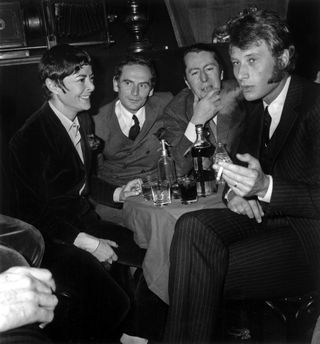
Though feted for many years, the artist’s reputation dipped precipitously in his own lifetime until he was practically persona non grata in the French scene. Pictured: Buffet with friends.

Foulkes suggests that Buffet, who died in 1999, blazed a trail as one of the first modern media artists. Pictured: the Buffets at Chateau l'Arc, near Aix-en-Provence – his main residence until 1964.
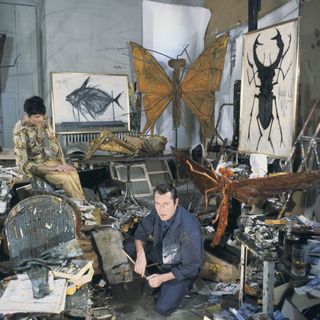
Buffet’s work was somehow denigrated by its transposition from gallery wall to suburban living room. Pictured: Buffet surrounded by work in the chateau.

Buffet described himself, stoically and stubbornly, as a ‘little detached suburban villa in the middle of modern painting’.
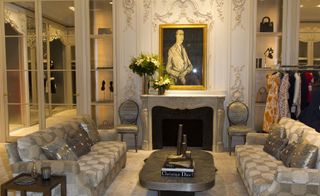
Buffet’s work is being reappraised by today’s market, as a new generation of collectors emerge, hungry for work with a provenance and a signature style. Pictured: Dior boutiqe.

Buffet and a selection of 'autoportraits'.
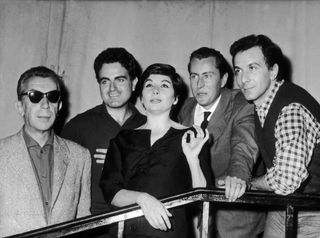
Buffet (second right) with (from left) painter and sculptor Albert Ayme, singer Guy Béart, and dancers Zizi Jeanmaire and Roland Petit.

Buffet is known to be one of France’s ‘fabulous five’, alongside director Roger Vadim, fashion designer Yves Saint Laurent (pictured here with Buffet), author Françoise Sagan and actress Brigitte Bardot.
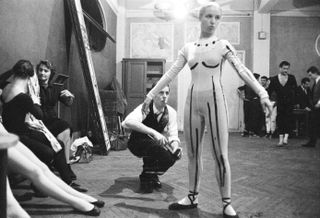
Foulkes explores Buffet’s changing milieu as an artist at the cradle of the media age. Pictured: Rendezvous with Bernard Buffet.

Foulkes offers a cautionary tale for artists who find themselves swept up then discarded by a fickle media.
INFORMATION
Bernard Buffet: The Invention of the Modern Mega-Artist, by Nicholas Foulkes £25, published by Preface Books. For more information, visit the publisher’s website
Wallpaper* Newsletter
Receive our daily digest of inspiration, escapism and design stories from around the world direct to your inbox
Jonathan Bell has written for Wallpaper* magazine since 1999, covering everything from architecture and transport design to books, tech and graphic design. He is now the magazine’s Transport and Technology Editor. Jonathan has written and edited 15 books, including Concept Car Design, 21st Century House, and The New Modern House. He is also the host of Wallpaper’s first podcast.
-
 Frank Stephenson’s high-flying capsule design for HALO’s balloon-powered space flights
Frank Stephenson’s high-flying capsule design for HALO’s balloon-powered space flightsSpace start-up HALO promises zero-emission travel to the stratosphere in a futuristic viewing capsule shaped by Frank Stephenson Design
By Jonathan Bell Published
-
 Back to Black: all eyes on film-maker Sam Taylor-Johnson
Back to Black: all eyes on film-maker Sam Taylor-JohnsonBack to Black cinematographer Polly Morgan tells Wallpaper* how a shared love of French New Wave close-ups brought Sam Taylor-Johnson’s Amy Winehouse biopic to life
By Craig McLean Published
-
 Formafantasma’s new collection explores nostalgia and the queer identity
Formafantasma’s new collection explores nostalgia and the queer identityFormafantasma present 'La Casa Dentro' at Fondazione ICA Milano (until 19 July 2024), where they draw inspiration from the domestic sphere and their own nostalgic perceptions of home
By Laura May Todd Published
-
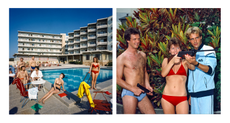 ‘Package Holiday 1968-1985’: a very British love affair in pictures
‘Package Holiday 1968-1985’: a very British love affair in pictures‘Package Holiday’ recalls tans, table tennis and Technicolor in Trevor Clark’s wistful snaps of sun-seeking Brits
By Caragh McKay Published
-
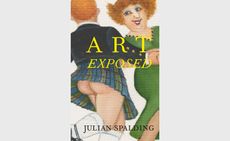 ‘Art Exposed’: Julian Spalding on everything that’s wrong with the art world
‘Art Exposed’: Julian Spalding on everything that’s wrong with the art worldIn ‘Art Exposed’, Julian Spalding draws on his 40 years in the art world – as a museum director, curator, and critic – for his series of essays
By Alfred Tong Published
-
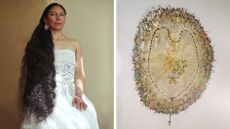 Marisol Mendez's ‘Madre’ unpicks the woven threads of Bolivian womanhood
Marisol Mendez's ‘Madre’ unpicks the woven threads of Bolivian womanhoodFrom ancestry to protest, how Marisol Mendez’s 'Madre' is rewriting the narrative of Bolivian womanhood
By Sofia de la Cruz Published
-
 Photo book explores the messy, magical mundanity of new motherhood
Photo book explores the messy, magical mundanity of new motherhood‘Sorry I Gave Birth I Disappeared But Now I’m Back’ by photographer Andi Galdi Vinko explores new motherhood in all its messy, beautiful reality
By Hannah Silver Published
-
 Best contemporary art books: a guide for 2023
Best contemporary art books: a guide for 2023From maverick memoirs to topical tomes, turn over a new leaf with the Wallpaper* arts desk’s pick of new releases and all-time favourite art books
By Harriet Lloyd-Smith Published
-
 The best photography books for your coffee table
The best photography books for your coffee tableFlick through, mull over and deep-dive into the best photography books on the market, from our shelves to you
By Sophie Gladstone Published
-
 Behind the scenes of Stanley Kubrick’s The Shining: new book charts the making of a horror icon
Behind the scenes of Stanley Kubrick’s The Shining: new book charts the making of a horror iconPublished in February 2023 by Taschen, a new collector's book will go behind the scenes of Stanley Kubrick’s The Shining, charting the unseen making of a film that defined the horror genre
By Harriet Lloyd-Smith Published
-
 Brad Walls’ aerial view transforms pools into artwork
Brad Walls’ aerial view transforms pools into artworkAerial photographer Brad Walls provides a crisp conclusion to the summer months with new book Pools From Above – you’ll want to dive right in
By Martha Elliott Last updated